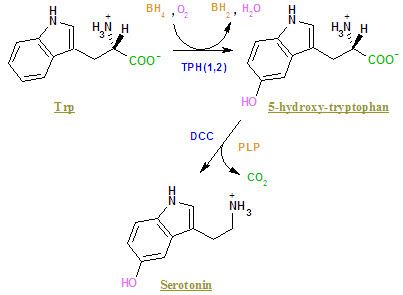EC number 1.14.16.4 ExPASy NiceZyme view | CAS number 9037-21-2 | |
 | ||
Tryptophan hydroxylase (TPH) is an enzyme (EC 1.14.16.4) involved in the synthesis of the neurotransmitter serotonin. Tyrosine hydroxylase, phenylalanine hydroxylase, and tryptophan hydroxylase together constitute the family of biopterin-dependent aromatic amino acid hydroxylases. TPH catalyzes the following chemical reaction
Contents
L-tryptophan + tetrahydrobiopterin + O2Function
It is responsible for addition of the -HO group (hydroxylation) to the 5 position to form the amino acid 5-hydroxytryptophan (5-HTP), which is the initial and rate-limiting step in the synthesis of the neurotransmitter serotonin. It is also the first enzyme in the synthesis of melatonin.
Tryptophan hydroxylase (TPH), tyrosine hydroxylase (TH) and phenylalanine hydroxylase (PAH) are members of a superfamily of aromatic amino acid hydroxylases, catalyzing key steps in important metabolic pathways. Analogously to phenylalanine hydroxylase and tyrosine hydroxylase, this enzyme uses (6R)-L-erythro-5,6,7,8-tetrahydrobiopterin (BH4) and dioxygen as cofactors.
In humans, the stimulation of serotonin production by administration of tryptophan has an antidepressant effect and inhibition of tryptophan hydroxylase (e.g. by p-Chlorophenylalanine) may precipitate depression.
The activity of tryptophan hydroxylase (i.e. the rate at which it converts L-tryptophan into the serotonin precursor L-5-hydroxytryptophan) can be increased when it undergoes phosphorylation. Protein Kinase A, for example, can phosphorylate tryptophan hydroxylase, thus increasing its activity.
Isoforms
In humans, as well as in other mammals, there are two distinct TPH genes. In humans, these genes are located on chromosomes 11 and 12 and encode two different homologous enzymes TPH1 and TPH2 (sequence identity 71%).
